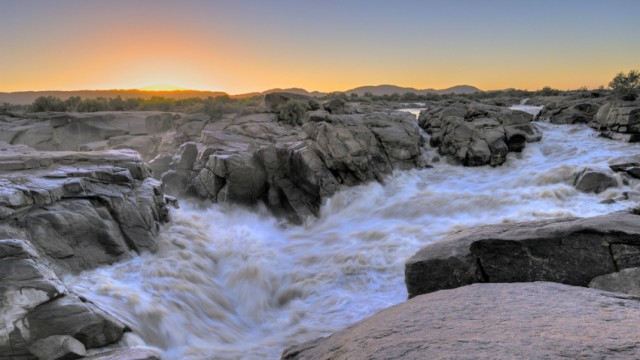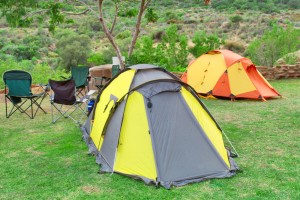Rafting the Orange River is one of South Africa’s best-value adventure holidays: a combination of paddling canoes over rapids and through spectacular scenery, swimming in the (crocodile free) river and camping under the stars far from any human habitation makes the perfect recipe for wholesome fun.
A 400-mile (640km) drive north of Cape Town, the Orange River forms a natural boundary with Namibia and traverses the Ai-Ais-Richtersveld Transfrontier Park. It’s here – on both the South African and the Namibian sides – that rafting trips start. For a couple of days after that, it’s just you, your canoe, your group of friends and a guide, and the beautiful desert of rippled sand dunes and craggy mountains (and the occasional baboon troop).
For the most part, the paddling is fairly easy going – there’s a bit of work involved and then a lot of floating and dips in the river to cool down, but there are some rapids to tackle, which gives you a bit of an adrenaline kick. Otherwise, far from any town, without cell phone signal and no need for a watch, time really starts to seem irrelevant, as you slip into an easy rhythm dictated by the river and the sun. At night you camp on the banks of the river, in the wild, metres from dunes, and drink red wine around the campfire before nodding off under a Milky Way canopy.
If you’re not into camping or roughing it, then this is probably not a good holiday option for you. But if you love getting away from civilization in the outdoors, a bit of adventure and sleeping under the stars, then you can’t do better than an Orange River rafting trip.
How to book an Orange River rafting trip
There are a number of operators on both the South African and Namibian sides of the border that offer guided trips along the river, ranging from one day to several days. On the whole the trips are budget-friendly and offer great value for money – they start at around R2610 per person, including all your meals.
You can opt to self-cater but you don’t pay much more to have all your meals catered for you, and going for the catered option does mean that you don’t have to worry about a thing other than keeping your drinks cold.
If you’re travelling in a big family or group of friends, you’ll be able to get your own private group and guide.
Amanzi Trails, which is in Namibia, is one of the most affordable options, and offers friendly, relaxed guides and simple but hearty meals. Bundi is almost the same price as Amanzi, while Gravity Adventures and Felix Unite are a bit pricier. All offer very similar guided trips, with catered and self-catering meal options.
What to expect
You’ll likely spend your first night at base camp, where there will be a campsite and ablutions. The next day, after a briefing, you’ll head out on the water with your guide and group. You’ll spend most of the days in your canoe, paddling and steering through rapids (which aren’t anything too scary), and also taking breaks to swim and lazily let your canoe drift downstream. If you’re not that fit, don’t worry – the paddling isn’t too intense, but you might find that you get stiff arms after a few days. You’ll stop off somewhere for lunch, paddle more in the afternoon and then make camp in the late afternoon.
If you’re on a catered trip, guides will start cooking dinner while you choose a spot to sleep. If you go on summer, you won’t want to sleep in a tent – it’s too hot. Instead, inflate your blow-up mattress, and get ready to sleep under the stars after a tasty dinner cooked over coals and some toasted marshmallows. Your morning will start with breakfast and coffee, made by the guides. You’ll pack up your canoes, slap on sunscreen and get ready for the next day. At the end of the trip you’ll get picked up on a truck and taken back to base camp – you won’t have to paddle upstream!
There are no toilets on the route. The great outdoors is your bathroom! Remember not to leave toilet paper on the ground – bring it back to camp with you in a brown paper bag. There are obviously no showers either. You feel fairly clean because you’re in the water all day, but if you want to wash, bring some biodegradable soap and wash in the river when you set up camp in the afternoon.
The canoes can capsize, especially when you’re going over rapids. You’ll be given plastic buckets with lids to keep all your clothes and sleeping bags in, in case you tip over – remember to bring big plastic trash bags to line the buckets and make them more waterproof.
When to go
It gets extremely hot in summer (November to March), when temperatures can reach 122 F (50C). If you can’t handle this extreme heat, choose to go between April and October, when the days are pleasant and evenings are cool (for nighttime pack warm clothes and thick sleeping bags). Despite the scorching temperatures, trips over New Year’s remain the most popular – each of the different companies offer New Year’s Eve parties back at base camp, either before or after your canoeing trip.
Tips
- Bring a beach umbrella and some rope and tie it onto your canoe to give you (and your cooler box) a bit of shade. It’s also handy for shading yourself while you swim in the river.
- Cover up! Many people underestimate the strength of the sun out there and get severely burned (and even get sunstroke) on their first day. Bring a wide-brimmed hat, big sunglasses, a sarong to cover your legs and feet and wear a long-sleeved shirt all day. Wear a high-factor SPF sunscreen and don’t forget to wear an SPF lip ice on your lips – they easily get burnt.
- Camping chairs and a blow-up mattress aren’t necessities, but they do make the camping part of the trip more comfortable.
- Bring a lot of Ziploc bags to keep things waterproof. If you’re bringing your camera, buy a waterproof bag for it.
- Bring old clothes that you don’t mind getting ruined – being in the water for most of the day will turn white clothes a permanent light shade of brown.
- Pack lots of snacks like dried fruit, nuts, chips and protein bars to munch on between meals – just keep them waterproof in zip loc bags.
- You might be tempted to pack your cooler box just with beers but remember to take some non-alcoholic drinks (other than water) to quench your thirst and replenish electrolytes lost during a day of sweating under the sun.


